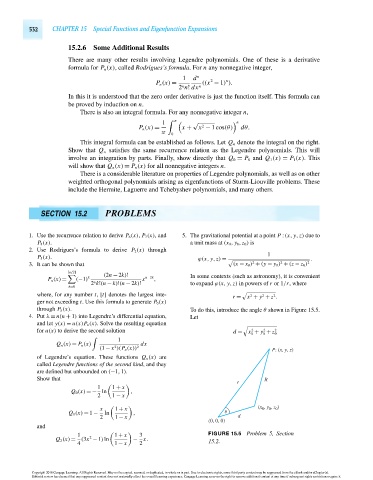Page 552 - Advanced_Engineering_Mathematics o'neil
P. 552
532 CHAPTER 15 Special Functions and Eigenfunction Expansions
15.2.6 Some Additional Results
There are many other results involving Legendre polynomials. One of these is a derivative
formula for P n (x), called Rodrigues’s formula.For n any nonnegative integer,
1 d n 2 n
P n (x) = ((x − 1) ).
n
2 n! dx n
In this it is understood that the zero order derivative is just the function itself. This formula can
be proved by induction on n.
There is also an integral formula. For any nonnegative integer n,
1 π √ n
2
P n (x) = x + x − 1cos(θ) dθ.
π 0
This integral formula can be established as follows. Let Q n denote the integral on the right.
Show that Q n satisfies the same recurrence relation as the Legendre polynomials. This will
involve an integration by parts. Finally, show directly that Q 0 = P 0 and Q 1 (x) = P 1 (x).This
will show that Q n (x) = P n (x) for all nonnegative integers n.
There is a considerable literature on properties of Legendre polynomials, as well as on other
weighted orthogonal polynomials arising as eigenfunctions of Sturm-Liouville problems. These
include the Hermite, Laguerre and Tchebyshev polynomials, and many others.
SECTION 15.2 PROBLEMS
1. Use the recurrence relation to derive P 6 (x), P 7 (x),and 5. The gravitational potential at a point P :(x, y, z) due to
P 8 (x). a unit mass at (x 0 , y 0 , z 0 ) is
2. Use Rodrigues’s formula to derive P 2 (x) through
1
P 5 (x). .
ϕ(x, y, z) =
2
2
3. It can be shown that (x − x 0 ) + (y − y 0 ) + (z − z 0 ) 2
[n/2]
(2n − 2k)! In some contexts (such as astronomy), it is convenient
P n (x) = (−1) k x n−2k ,
n
2 k!(n − k)!(n − 2k)! to expand ϕ(x, y, z) in powers of r or 1/r,where
k=0
where, for any number t, [t] denotes the largest inte- 2 2 2
r = x + y + z .
ger not exceeding t. Use this formula to generate P 0 (x)
through P 5 (x). To do this, introduce the angle θ shown in Figure 15.5.
4. Put λ = n(n + 1) into Legendre’s differential equation, Let
and let y(x) = u(x)P n (x). Solve the resulting equation
2
2
for u(x) to derive the second solution d = x + y + z 2
0 0 0
1
Q n (x) = P n (x) dx
2
(1 − x )(P n (x)) 2 P: (x, y, z)
of Legendre’s equation. These functions Q n (x) are
called Legendre functions of the second kind,and they
are defined but unbounded on (−1,1).
Show that R
r
1 1 + x
Q 0 (x) =− ln ,
2 1 − x
x
1 + x (x , y , z )
0
0
0
Q 1 (x) = 1 − ln , θ
2 1 − x d
(0, 0, 0)
and
1
1 + x 3 FIGURE 15.5 Problem 5, Section
2
Q 2 (x) = (3x − 1)ln − x. 15.2.
4 1 − x 2
Copyright 2010 Cengage Learning. All Rights Reserved. May not be copied, scanned, or duplicated, in whole or in part. Due to electronic rights, some third party content may be suppressed from the eBook and/or eChapter(s).
Editorial review has deemed that any suppressed content does not materially affect the overall learning experience. Cengage Learning reserves the right to remove additional content at any time if subsequent rights restrictions require it.
October 14, 2010 15:20 THM/NEIL Page-532 27410_15_ch15_p505-562

